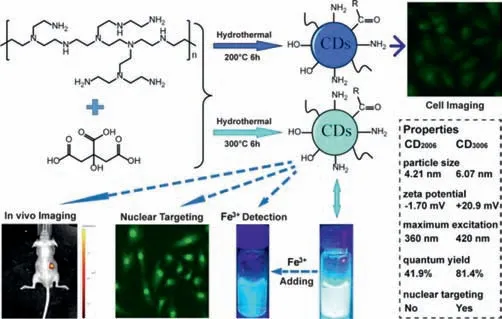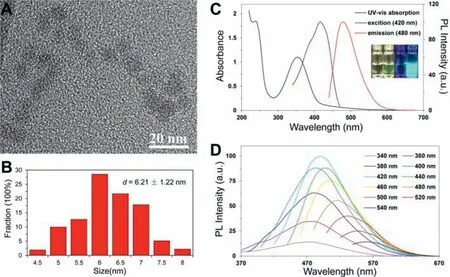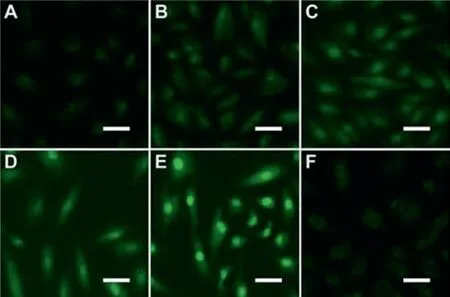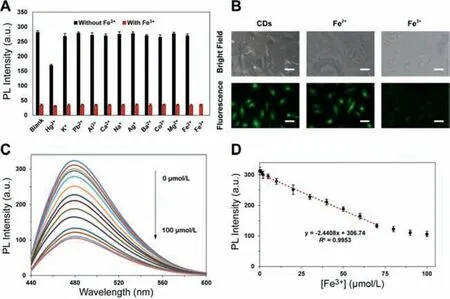One-pot synthesis of nuclear targeting carbon dots with high photoluminescence
2021-03-14PengchongWangHongruiJiShiyanGuoYingZhangYanYanKeWangJianfengXingYalinDong
Pengchong Wang,Hongrui Ji,Shiyan Guo,Ying Zhang,Yan Yan,Ke Wang,∗,Jianfeng Xing,∗,Yalin Dong
a Department of Pharmacy,the First Affiliated Hospital of Xi’an Jiaotong University,Xi’an 710061,China
b School of Pharmacy,Xi’an Jiaotong University,Xi’an 710061,China
Keywords:Optimization of synthesis process Fluorescence quantum yield improving Nuclear targeting Bioimaging Ferric ion detection
ABSTRACT Carbon dots (CDs) are novel fluorescent nanomaterials with good water solubility,high resistance to photobleaching and low toxicity.While,there are few studies elaborate on the relationship among reaction conditions,properties and applications of CDs.In this study,a series of CDs are synthesized through a one-pot hydrothermal method,and different reaction conditions are carried out to study the influencing factors of CDs properties.As a result,with the increase of temperature and reaction time,the particle size and zeta potential of CDs increased,the maximum emission wavelength red-shifted and the fluorescence quantum yield (QY) improved.Among them,CD3006 has good water solubility and highest QY of 81.4%,which is beneficial for its applications in bioimaging and ion detection.CD3006 is almost nontoxic in cells at a concentration of 500 μg/mL.In addition,the positive charged CD3006 shows nuclear targeting potential because of its combination with DNA through electrostatic interaction in nucleus.The properties of CDs can be greatly enhanced by controlling reaction conditions,and it provides great application prospects.
Carbon dots (CDs) are novel nanomaterials with carbon as basic component element,their particle size is less than 10 nm,they are nearly spherical in solution and rich of organic functional groups on the surface,so CDs have been widely concerned and studied [1,2].CDs have excellent photoluminescence (PL) properties,good photostability,low toxicity and sufficient active sites,which make them have great application potential in many fields [3-5].In recent years,with the development of preparation methods and functional modifications,the fluorescence performance [6,7],water solubility [8],biocompatibility [9]and emission wavelength [10,11]of CDs have been greatly improved.CDs have been applied in the fields of biosensor,photocatalysis,luminescent materials,bioimaging,ion detection,disease diagnosis and treatment [12-16].
At present,low fluorescence quantum yield (QY) is still a problem limiting the application of CDs [17-20].Surface passivation[21-23]and heteroatom doping [24,25]are the most commonly used methods to improve the fluorescence properties of CDs.Such methods are easy to operate and the obtained CDs show good water solubility,stable fluorescence and good biocompatibility.However,QY of the most prepared CDs is not higher than 50% and limited to UV (360 nm) excitation [26,27],which will restrict their application gravely.Some literatures indicated that the QY of CDs can also be greatly affected by reaction conditions,such as temperature,reaction time or passivator [6].Previous studies seldom elaborate on the influence factors and mechanisms to fluorescence performance of CDs,and the biological characteristics can also be affected by adjusting reaction conditions,which may greatly improve the application of CDs.
In this study,a series of nitrogen doped CDs were preparedviaa one-pot method.The influence of reaction conditions on CDs properties was researched.By controlling reaction time and temperature,the QY of CDs was greatly improved,and beneficial to their applications in bioimaging.The positive charge density of CDs was also enhanced,leading to nuclear targeting imaging in living cells.In addition,CDs also have great application prospects in cellular ferric ion (Fe3+) detection andin vivobioimaging.
CDs were synthesizedviaa hydrothermal method and applied in different fields (Scheme 1).Citric acid (CA) was precursor and polyethyleneimine (PEI) was passivator for CDs preparation.The influence of reaction time,temperature,different amount or molecular weight of PEI on the state of products,and the QY and particle size of CDs were investigated.

Scheme 1.Schematic diagram illustrating the preparation,properties and applications of CDs.
As shown in Table S1 (Supporting information),with the increase of reaction time and temperature,the color of products became darker and the products became insoluble in water,indicating the carbonization degree increased.Comparing with the 360 nm maximum excitation wavelength of CD2006(CDs prepared under 200 °C for 6 h),CD3006(CDs prepared under 300 °C for 6 h) has a red-shifted maximum excitation wavelength of 420 nm.Therefore,the QY at 360 nm and 420 nm were measured to study the change of the maximum excitation wavelength and photoluminescence of CDs.As shown in Figs.S1A and B (Supporting information),with the rising of temperature,the QY in 360 nm rose rapidly and then reduced gradually,this phenomenon in 420 nm was lagged behind.CD3006showed the highest QY in 420 nm.As shown in Fig.S1C (Supporting information),the amount and molecular weight of PEI could also affect the QY of CDs,0.5 g PEI1800showed the highest QY.As shown in Fig.S1D (Supporting information),with the increase of reaction time and temperature,the average particle size of CDs enlarged.When temperature exceeded 300 °C,the particle size increases excessively,indicating the over carbonization of CDs.TEM images of some CDs were shown in Fig.S2 (Supporting information),compared with the homogeneous spherical CD3006,CD2006was smaller and hardly to form a uniform structure,CD3003(CDs prepared under 300 °C for 3 h) showed small amount of loose structure,CD3503(CDs prepared under 350 °C for 3 h) was with high density particles different in both shape and size.With the increase of carbonization,the particle size and the density of CDs were increased.Within limits,the fluorescence properties of CDs could be improved with larger size.In addition,the QYs of CD3006in 360 nm and 420 nm were also changed from 56.8% and 63.5% to 42.3% and 81.4% after dialysis,indicating that removing smaller CDs leads to the red-shift of fluorescence emission and is beneficial for improving QY.
According to above results,the reaction time and temperature were positively correlated with carbonization degree,when the degree of carbonization was higher,the particle size of CDs was larger.In addition,with the increase of particle size,the fluorescence emission spectrum was red-shifted and the QY was increased.It was considered that,with the increase of carbonization,carbon nanonucleus was formed and grew gradually,more PEI was trapped and coated on the surface of carbon nanoparticles,the surface defects became more stable.In addition,the doped N atom in carbon nucleus can form more conjugated system at high temperature,change the band gap and charge structure of CDs,offer potential active sites and greatly improve the fluorescence intensity.Meanwhile,as the temperature and reaction time increased,surface groups of CDs might be oxidized and the oxygen content increased,contributing to the red-shift of fluorescence emission.However,as the carbonization got higher,the particle size increased excessively,most of the CDs agglomerated and became insoluble in water,the PL and the QY decreased.CDs prepared at 300 °C for 6 h with 0.5 g of PEI1800were chosen as the optimal reaction condition,the QY of CD3006is 81.4%,which is much higher than the reported 20%-60% [28-30].
The TEM image (Fig.1A) illustrated that CD3006are uniform nanospheres with an average diameter of 6.21 ± 1.22 nm (Fig.1B).The mean size of CD3006measured by DLS (Fig.S3 in Supporting information) was 6.07 ± 0.99 nm,which was similar to that of TEM.The XRD pattern of CD3006(Fig.S4A in Supporting information) showed a broad peak at 2θ=22.1°,corresponding to the highly disordered carbon atoms and amorphous structure.As shown in Fig.S4B (Supporting information),FTIR spectroscopy characterized the functional groups on CD3006,absorption band at 3413 cm-1represented the stretching vibrations of-OH and-NH,band at 2963 cm-1was assigned to the stretching vibrations of C-H,bands at 1719 was associated with C=O and C=C stretching vibrations,bands at 1395 and 1274 cm-1were consistent with CN and ester groups stretching vibrations.XPS was carried out to investigate the element compositions and surface states of CD3006.As shown in Fig.S4C (Supporting information),3 dominant peaks at 285,399 and 532 eV are observed,the composition of CD3006was C 76.3 wt%,N 5.01 wt% and O 17.5 wt%.Moreover,the highresolution XPS (Figs.S4D-F in Supporting information) showed the peaks at 284.4,285.7 and 288.3 eV,corresponding to C-H/C-C/C=C,C-O and C=O;the peaks at 530.3,531.7 and 533.1 eV,corresponding to C-O,C=O and C-OH/C-O-C;the peaks at 399.1 and 400.1 eV,corresponding to N-H and N-C.The surface functional groups observed in XPS spectra showed good agreement with that in FTIR spectra,suggesting the CD3006possessed a sufficient number of amino,hydroxyl,carboxyl and amide groups,which was beneficial for the modification and application.
As shown in Fig.1C,the UV-vis absorption,PL excitation,and emission spectra of CD3006solution were investigated.The UVvis absorption spectrum had 2 typical absorption peaks at 239 and 354 nm,corresponding to theπ–π∗transition of the conjugated C=C bond,which cannot produce fluorescent signal,and n–π∗transition of the C=O bond,the trapping excited state energy of the surface states leaded to the produce of fluorescence signal.The blue and red lines in Fig.1C showed the excitation and emission peaks of CD3006at 420 and 480 nm,respectively.Fig.S5 (Supporting information) showed the fluorescence emission of CD3006solution under different excitation laser.Fig.S6 (Supporting information) showed that the average decay time of CD3006was 13.48 ns,which was much longer than the biological autofluorescence(shorter than 5 ns) [31].Fig.1D showed the characteristic wavelength dependent emission of CD3006,indicating the formation of CDs.
As shown in Fig.S7 (Supporting information),the 420 nm absorbance of CD3006was measured at different concentrations.The absorbance showed a nearly linear relationship (R2=0.9964) with the concentration of CD3006in the range of 5-200 μg/mL.And the PL intensity (fluorescence intensity of 480 nm,F480) also showed a nearly linear relationship (R2=0.9991) with the concentration of CD3006in the range of 10 to 250 μg/mL.The PL intensities of CD3006under different pH were shown in Figs.S8A and B (Supporting information),with the increase of pH value,PL intensity of CD3006rose rapidly and then reduced gradually,the strongest fluorescence appeared at pH 4.Figs.S8C and D (Supporting information) showed the PL intensity of CD3006in different disperse medium,PL intensity only decreased slightly in 10% serum medium.Fig.S9 (Supporting information) showed the photostability of CD3006,the PL intensity remained stable except under UV light.These results reflected good photostability of CD3006.As shown in Fig.S10 (Supporting information),in contrast with FITC,CD3006remained strong fluorescence after mercury lamp irradiation for 5 min,indicating CD3006possessed potential for bioimaging.

Fig.1.(A) TEM image and (B) corresponding particle size of CD3006.(C) UV-vis absorption,PL excitation,and emission spectra of CD3006 solution.Insets show photographs of deionized water and CD3006 solution under visible (left) and UV (right) light.(D) PL emission spectra of CD3006 with different excitation wavelengths.
The cell viabilities of A549,MDA-MB-231,MCF-7 and HEK293 cells incubated with CD3006were shown in Fig.S11A (Supporting information),the cell viabilities decreased less than 6% after 48 h incubation with 100 μg/mL of CD3006,suggesting the low cytotoxicity of CD3006.Fig.S11B (Supporting information) showed that the hemolysis ratio of CD3006was less than 5% at a concentration of 1000 μg/mL,revealing the good biocompatibility of CD3006.The nontoxic raw materials of CA and low molecular PEI1800contributed to the satisfactory biosafety of CDs.
The cellular fluorescence imaging was studied at a CD3006concentration of 100 μg/mL.A549,HEK293 and MDA-MB-231 cells were incubated with CD3006for 24 h.Fig.2A showed the fluorescence images of cells,fluorescence signal was found to be accumulated in nuclear substance,especially in A549 and MDA-MB-231 cells.Fig.2B showed the CLSM fluorescence images of A549 cells for observing the cellular distribution of CD3006.The cellular internalization of CD3006was increased as time goes on,A549 cell nucleus showed obvious fluorescence at 12 h.This result indicated that CD3006had target imaging towards nucleus,it was hypothesized that the PL intensity of CD3006might be enhanced by reacting with nuclear substance or CD3006could be accumulated in nucleus.
Up to now,few CDs showed accumulating towards cellular nucleus.CDs should be smaller than 8 nm (a general size of cell nuclear pore) to overcome multiple barriers to enter cellular nucleus[32].In order to explore the nuclear staining mechanism of CD3006,DNA,nucleus or cytoplasm extracted from A549 cells were incubated with CD3006.The PL intensities of CD3006(Fig.S12 in Supporting information) remained unchanged,suggesting the fluorescence intensity of CD3006would not be enhanced when it was reacted with DNA,nucleus or cytoplasm.Therefore,CD3006was hypothesized to be enriched in nucleus.In order to explain this phenomenon,zeta potential of CDs was investigated,as shown in Fig.S13 (Supporting information),raw CDs (without PEI passivation)had a zeta potential of-29.1 ± 5.55 mV,while CD3003,CD3006and CD3503had reversed zeta potential of 10.6 ± 3.61 mV,20.9 ±4.09 mV and 18.3 ± 4.54 mV,respectively,indicating that PEI could make CDs positively charged.On the other hand,zeta potential of CD2003and CD2006was-6.33 ± 5.22 mV and-1.70 ± 6.35 mV.With the increase of carbonization,the nanonucleus of CDs formed and grew gradually,and more PEI could be trapped and coated on the surface,so that the positive charge density of CDs was raised.PEI on the surface of CDs is conducive to the penetration through cell membrane and nuclear membrane.The positive charged CDs will be binded with DNA after entering nucleus,and cannot across the nuclear pore freely,so CDs can be accumulated in nucleus.

Fig.2.(A) Fluorescence images of A549,HEK293 and MDA-MB-231 cells incubated with CD3006 at a concentration of 100 μg/mL for 24 h.(B) CLSM fluorescence images of A549 cells incubated with 100 μg/mL of CD3006 for different time.Scale bars for all images are 50 μm.
To verify this hypothesis,CD3006was added into DNA solution with a mass ratio of 1:1,after vortexing for 15 s,the mixture was incubated at room temperature for 30 min.CDs and CD3006/DNA were incubated with A549 cells for 24 h,fluorescence images were shown in Fig.3.Raw CDs and CD2006showed weak fluorescence because of the poor QY and negative zeta potential.CD3003,CD3006and CD3503showed nuclear target imaging because of the high QY and positive zeta potential.CD3006showed the best nuclear target imaging because of the highest QY.However,in CD3006/DNA group,only feeble fluorescence was observed mainly in cytoplasm,indicated that the enlarged size and decreased zeta potential hindered the penetration of CD3006/DNA through cell membrane and nuclear membrane.

Fig.3.Fluorescence images of A549 cells incubated with (A) raw CDs,(B) CD2006,(C) CD3003,(D) CD3503 (E) CD3006 and (F) CD3006/DNA at a concentration of 100 μg/mL for 24 h.Scale bars for all images are 50 μm.
Thein vivobioimaging results were shown in Fig.S14 (Supporting information),after subcutaneous or intradermal injection of CD3006in mice (as shown in Figs.S14A-F),strong fluorescence signal was appeared,reflecting the goodin vivobioimaging capability.The fluorescence signal dispersed after 6 h of subcutaneous injection,this may be due to the diffusion of CDs in subcutaneous tissue.After intravenous injection of CD3006,fluorescence signal was appeared in urine within a few minutes.After 6 h,no obvious fluorescence was found in tissues,organs or feces,only weak fluorescence could be seen in the bladder and caudal vein (as shown in Figs.S14G-I),which indicated that CD3006was excreted rapidly in urine after intravenous injection.All animal care and experimental protocols were in strict accordance with the Guidelines of the Laboratory Animal Center of Xi’an Jiaotong University and approved by the Institutional Animal Care and Ethics Committee of Xi’an Jiaotong University (No.XJTULAC2016-004).
PL intensity of CD3006decreased remarkably after adding Fe3+.Other metal ions were also added,only Hg2+had a certain influence on the PL intensity (Fig.4A,Fig.S15 in Supporting information).As shown in Fig.S16 (Supporting information),the PL intensity of CD3006decreased in 5 min after adding Fe3+.Figs.4C and D showed that PL intensity had a linear relationship with Fe3+concentration in the range of 0-70 μmol/L.Using the 3σrule(σ=S0/S,S0is the standard deviation of the blank solution after repeated measurements,and S is the gradient of the standard curve),the detection limit was 127.1 nmol/L,indicating the high sensitivity of CD3006.To demonstrate the practical application,the accuracy of the method was evaluated at three concentration levels of spiked samples.The results were showed in Table S2 (Supporting information),the recovery percentage was in the range of 91.0%–102.6%,revealing the good accuracy of this method for the quantitative of the concentration of Fe3+.To investigate the Fe3+detection in living cells,A549 cells were incubated with CD3006for 12 h,after that Fe2+or Fe3+was added.Fig.4B showed that the fluorescence of A549 cells incubated with CD3006and Fe2+remained unchanged,while the fluorescence decreased significantly when incubated with Fe3+.Fe3+might turn-off the fluorescence of CD3006due to its active reactions with surface functional groups of CD3006.This would make complexes between them,and the metal complexes would comfort charge-transfer and restrict the recombination of excitons,resulting in the fluorescence quenching behavior.
In summary,nuclear targeting nitrogen-doped CDs with high PL were synthesizedviaa hydrothermal one-pot method,which takes CA as precursor and low toxic PEI1800as passivator.The particle size and positive charge density of CDs were increased by controlling reaction time and temperature,in order to enhance their QY and nuclear targeting.The synthesized CD3006showed good water solubility,photostability,biosafety,high PL and nuclear targeting,indicating its application potential in targeting drug delivery,bioimaging and ion detection.

Fig.4.(A) PL intensities after adding metal ions without or with Fe3+.The concentration of each metal ion was 1 mmol/L.(B) Fluorescence images of A549 cells incubated with Fe2+ or Fe3+ for 24 h.Scale bars for all images are 50 μm.(C) PL emission spectra of CD3006 with different concentrations of Fe3+ and (D) the dependence of PL intensity on the concentration of Fe3+.Data are mean ± SD (n=3).
Declaration of competing interest
The authors declare that they have no known competing financial interests or personal relationships that could have appeared to influence the work reported in this paper.
Acknowledgments
This work was supported financially by the National Natural Science Foundation of China (Nos.81773663 and 81973253).We also thank the Instrument Analysis Center of Xi’an Jiaotong University for the help of measurement.
Supplementary materials
Supplementary material associated with this article can be found,in the online version,at doi:10.1016/j.cclet.2021.05.005.
杂志排行
Chinese Chemical Letters的其它文章
- Progress in mechanochromic luminescence of gold(I) complexes
- Spinel-type bimetal sulfides derived from Prussian blue analogues as efficient polysulfides mediators for lithium-sulfur batteries
- Alopecuroidines A-C,three matrine-derived alkaloids from the seeds of Sophora alopecuroides
- Boronic acid-containing diarylpyrimidine derivatives as novel HIV-1 NNRTIs:Design,synthesis and biological evaluation
- Diaminodiacid bridge improves enzymatic and in vivo inhibitory activity of peptide CPI-1 against botulinum toxin serotype A
- Peptide stapling with the retention of double native side-chains
